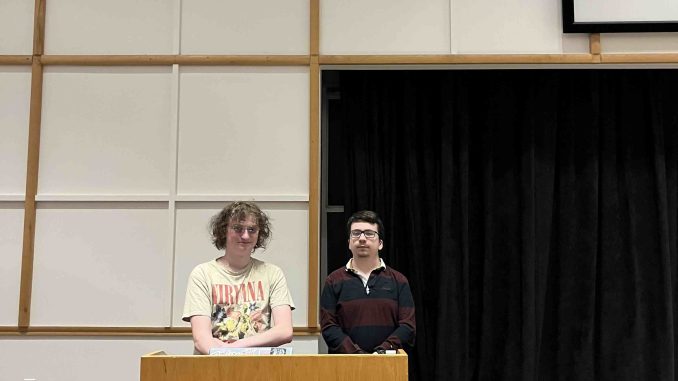
This article contains light spoilers for the animated film Nimona (2023). On Friday April 18th, the Gender and Sexuality Alliance (GSA) and Film Club collaborated to host a screening of the 2023 animated movie Nimona followed by an open discussion on the aspects of representation shown in the film. The event, titled “Portrayals of Identity: Conversations about representation of marginalized groups in modern film,” was designed to both show students a movie containing strong queer representation as well as to talk about how different marginalized groups are displayed in media. Nimona is adapted from the graphic novel by ND Stevenson, categorized in the adventure/fantasy genres. Set in a futuristic style medieval world, the story follows Ballister Boldheart, a knight framed for a murder he didn’t commit. With everyone turned against him, including his boyfriend and fellow knight Ambrosius Goldenloin, Ballister has no choice but to accept the help of a shapeshifting teen, Nimona. The movie details their journey as themes of betrayal, love, and identity are put on display to viewers, promoting discussions of representation. GSA member Blake McNulty ’26 organized the event alongside the president of Film Club, Danny McGrath ’26. McNulty shared the idea behind the event, explaining, “It was meant to be an open discussion on what different representations were in the film.” McGrath opened the discussion by asking, “So what do we think about the representation in the film?” One of the first topics mentioned was the inclusion of a gay couple of color, with the main character being in that relationship. “There is obviously a lot of trans allegory,” commented McGrath, in reference to Nimona’s character, who through shapeshifting represents an identity struggle commonly experienced by those who have/are transitioning.
McNulty then posed the question, “Do you think this a good representation of those groups?” Naila Twyman ’26 chimed in, “I definitely want to say it’s a good representation of what a gay couple is, pretty hands down.” McGrath commented more on the trans allegory, stating, “I think it is a pretty good representation, especially because it’s not like there’s trans people all throughout this movie that are just characters, but it’s obviously talking about that specifically.” Twyman spoke about this sharing, “They do switch the pronoun a lot (in reference to Nimona’s character). It would go from referring to her as she and then when they’re dehumanizing her, it.” “Which is very representative of a lot of trans experiences,” remarked McGrath in response.
A theme in the movie was the acceptance and inclusion of Ballister and Ambrosius as a gay couple, but not of Nimona, a “monster” who doesn’t keep a set identity of human or animal. “I think that’s a good commentary on the queer community because to a certain point there’s people who are accepting of gay people, but then there’s also, when you get to that point of being accepting of gay people, you also have to be accepting of trans people and their identities,” explained McGrath. Ballister himself displayed a struggle to understand Nimona’s identity, often asking her to just be normal, or to just be a girl. “Unfortunately, that’s a lot of people when they are coming to terms with knowing a trans person,” McGrath said. Nimona as a whole offers insight onto the ways these marginalized groups can be represented in modern film. Providing a platform for open discussion after the screening was aimed to get more people talking and sharing their thoughts on these representations, something McNulty was happy to have achieved. The GSA and Film Club may collaborate again in the future, so keep an eye out for any upcoming events to be a part of!
